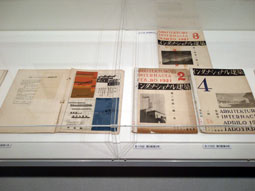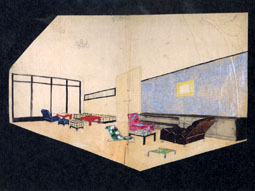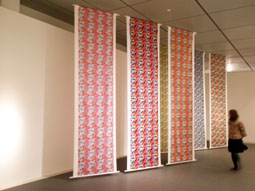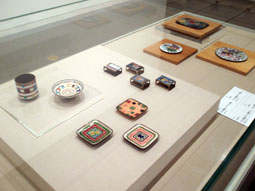 |
|
 |
International Architecture magazine (published 1929-33)
|
|
Isaburo Ueno, Takatsu House, interior sketch (Nishinomiya, 1933) |
|
In 1933 Isaburo Ueno (1892-1972), a founding member of the International Architecture Association of Japan, took German modernist architect Bruno Taut to see the 17th-century Katsura Imperial Villa. Taut's brief visit resulted in his famous proclamations that Katsura was a superb example of architectural "functionalism," a paradigm of modernism avant la lettre. Yet Arata Isozaki suspects that it was all a setup orchestrated by Ueno: Taut was invited in the hope that his statements would help in the resistance to government policies that enforced the neotraditional teikan ("Imperial Crown") style for new public buildings.
"They believed that modernism in architecture might replace the elevational eclecticism of the teikan style, if only they could isolate the key compositional elements common to traditional Japanese architecture and modern design. They needed, however, an authoritative spokesperson. Taut intuitively understood his role and played it to the hilt." *
Though this is not to say that the interpretation was entirely wrong or Taut's behavior was entirely corrupt, Ueno and many other Japanese architects did indeed use this external validation of Katsura as ammunition to defend the influence of European modernism on their own work.
Ueno came from a family line of miya daiku (temple carpenters), but chose to study architecture at Waseda University in Tokyo. After graduation, he spent four years studying in Berlin and Vienna, during which time he also worked in the office of Viennese architect Josef Hoffmann. In 1925 he met and married Felice Rix (1893-1967), and they moved to Japan the following year. The eldest daughter of a wealthy Viennese businessman, Rix had studied at the Viennese School of Applied Arts and was already a prizewinning designer in her own right.
Back in Kyoto, Ueno established an architecture office, for which Felice was in charge of interiors, product design, textiles, wallpapers, and the like. Politically astute and well-connected, Ueno soon founded the International Architecture Association of Japan together with peers and colleagues from Kyoto and Osaka as well as a number of the architects he had met in Europe, including Taut, Hoffmann, Erich Mendelsohn, Peter Behrens, Gerrit Rietveld, and Walter Gropius.
The current exhibition at the National Museum of Modern Art in Kyoto includes the full range of work produced by Ueno and Rix, much of it never before displayed. The Kyoto Interactive School of Art (formerly the International Design Research Institute, which the couple established in 1963) has donated their entire archive of relevant works and documents, including a complete collection of International Architecture, the magazine produced by the International Architecture Association of Japan.
The architectural designs on display include examples of their many collaborative projects in Kyoto, such as the 1931 Star Bar (also included in the seminal "International Style" exhibition held at New York's MoMA in 1932) and the VIP Room of the Kyoto City Hall. There are samples of Rix's designs for matchboxes, fabrics, and wallpapers, as well as her watercolors and interpretations of emakimono (Japanese picture scrolls). The exhibition is structured so as to show the way in which their collective output gradually shifted away from buildings toward arts and crafts. Working with Kyoto's printing and textile artisans, Ueno and Rix were able to bring the crisp compositions and vibrant colors of early-20th-century Vienna into a powerful and influential synthesis with the understated elegance of old Kyoto. While not proving that a proto-modernism is latent in Japanese tradition, this exhibition does convincingly demonstrate their compatibility.
* Arata Isozaki, Japan-ness in Architecture, trans. Sabu Kohso. Cambridge: MIT Press, 2006, pp.10-11.
 |
|
 |
| Felice Rix-Ueno, print designs (c.1955) |
|
Felice Rix-Ueno, plates and matchbox covers (c.1950) |
|
|